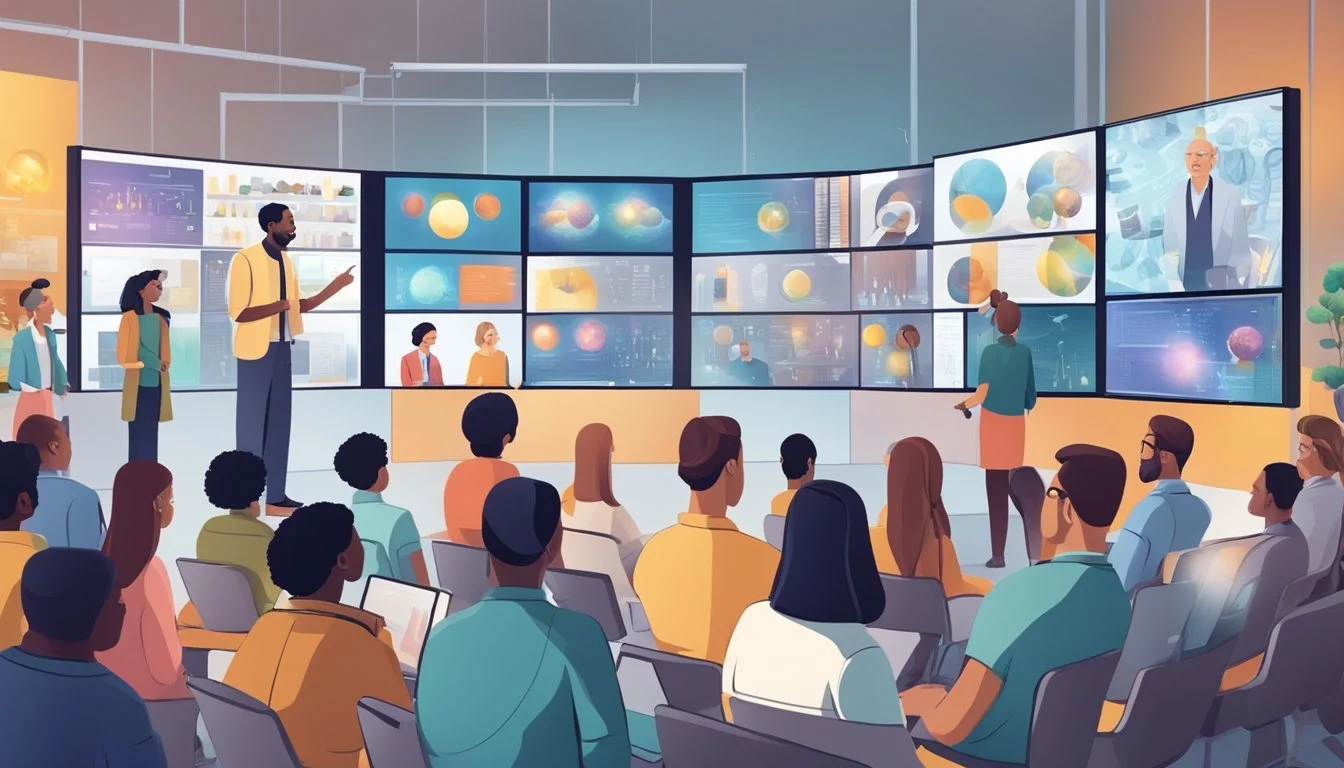10 Documentaries That Explore the Science of Human Attraction and Beauty
Unveiling the Secrets of Allure
Documentaries exploring the science of human attraction and beauty offer fascinating insights into the complex biological and psychological factors that influence our romantic and aesthetic preferences. These films combine expert analysis, cutting-edge research, and compelling personal stories to shed light on the often mysterious processes underlying physical and emotional attraction.
By examining topics like the neurochemistry of love, evolutionary biology, and cultural influences on beauty standards, these documentaries provide viewers with a deeper understanding of why we find certain people attractive. From exploring the role of pheromones in mate selection to investigating how facial symmetry impacts our perceptions of beauty, these films reveal the intricate mechanisms at work in human relationships and social interactions.
1) Vanity Fair: Killing Us Softly
Killing Us Softly is a groundbreaking documentary series by Jean Kilbourne that examines the portrayal of women in advertising. The series began in 1979 and has been updated several times, with the most recent version released in 2010.
Kilbourne's work focuses on how advertisements perpetuate gender stereotypes and negatively impact women's self-image. She analyzes a wide range of print and television ads, demonstrating how they objectify women's bodies and promote unrealistic beauty standards.
The documentary explores the connection between advertising and broader societal issues. It highlights how media representations contribute to problems like eating disorders, low self-esteem, and gender violence.
Killing Us Softly has been widely used in educational settings. The Media Education Foundation has distributed the film to thousands of colleges, universities, and other institutions, making it a valuable tool for media literacy.
By encouraging critical thinking about popular culture, the documentary challenges viewers to consider the deeper implications of the images they encounter daily. It remains relevant in today's media-saturated environment, where advertising continues to shape cultural norms and expectations.
[https://en.wikipedia.org/wiki/Killing_Us_Softly]
2) The Self-Made Beauty
"The Human Face" explores the science behind physical attractiveness and its impact on society. This documentary examines how facial features influence perceptions of beauty and the role of symmetry in human attraction.
The film delves into the evolutionary aspects of beauty preferences and how they have shaped human mating behaviors. It also investigates the psychological effects of perceived attractiveness on social interactions and personal success.
"The Human Face" features interviews with researchers and experts in fields such as anthropology, psychology, and biology. These discussions provide insights into the complex interplay between genetics, environment, and cultural influences on beauty standards.
The documentary also addresses the growing trend of cosmetic procedures and their societal implications. It raises questions about the pursuit of physical perfection and its effects on individual well-being and social dynamics.
[https://www.imdb.com/title/tt0339581/]
3) The Human Face
"The Human Face" is a compelling four-part BBC documentary series that delves into the science behind facial beauty, expression, and fame. Hosted by renowned comedian John Cleese, the series offers an entertaining and informative exploration of human facial features.
The documentary examines various aspects of the human face, including identity, perception, creativity, and sexuality. It combines scientific insights with art, technology, and human interest stories to provide a comprehensive look at facial characteristics.
Prominent psychologist Paul Ekman served as the scientific adviser for the series, lending his expertise to the production. The show features appearances by notable figures such as David Attenborough and Pierce Brosnan, adding depth to its content.
"The Human Face" covers topics like the value of laughter and micro-expressions, providing viewers with a fascinating journey through the complexities of facial science. The series offers a unique blend of education and entertainment, making it accessible to a wide audience.
4) Beauty Mark
Beauty Mark is a thought-provoking documentary that examines society's obsession with physical appearance and its impact on individuals. The film follows Diane Israel, a former champion triathlete, as she explores her own struggles with body image and eating disorders.
Through interviews with experts and personal stories, Beauty Mark sheds light on the cultural pressures that drive people to extreme measures in pursuit of an idealized beauty standard. The documentary addresses the influence of media, advertising, and societal expectations on self-perception.
Viewers gain insights into the psychological and emotional toll of striving for physical perfection. The film also touches on the beauty industry's role in perpetuating unrealistic standards and the potential health consequences of body dissatisfaction.
Beauty Mark encourages viewers to question traditional beauty norms and embrace a more inclusive definition of attractiveness. It offers a critical examination of how cultural ideals shape our perceptions of ourselves and others.
https://www.imdb.com/title/tt1290915/
5) The Science of Sex Appeal
The Science of Sex Appeal is a fascinating documentary that delves into the biological underpinnings of human attraction. Produced by Discovery Channel in 2010, this program examines how genetics, hormones, and neurological factors influence sexual attraction between individuals.
The documentary challenges conventional notions of romance by presenting scientific explanations for what we often perceive as mysterious or magical. It breaks down various aspects of human sex appeal, exploring their evolutionary origins and biological functions.
Viewers are given insight into the subtle cues and signals that play a role in attraction, from physical features to pheromones. The program also investigates how our brains process these signals and how they influence our behavior and choices in potential mates.
Through interviews with experts and cutting-edge research, The Science of Sex Appeal offers a comprehensive look at the complex interplay of factors that contribute to human attraction. It provides a unique perspective on relationships and mating behaviors, grounded in scientific evidence.
This documentary serves as an enlightening exploration of human sexuality, offering viewers a chance to understand the biological mechanisms behind romantic and sexual attraction.
[https://www.imdb.com/title/tt1474677/]
6) The Truth About Looking Good
The Truth About Looking Good is a thought-provoking BBC documentary that delves into the science behind beauty and attraction. Hosted by Cherry Healey, this film explores various aspects of the beauty industry and their impact on consumers.
The documentary investigates popular beauty treatments and products, subjecting them to scientific scrutiny. It examines the effectiveness of anti-aging creams, hair loss remedies, and other cosmetic interventions.
Healey consults with experts in dermatology, psychology, and cosmetic science to uncover the truth behind beauty claims. The film provides valuable insights into which treatments actually work and which may be little more than marketing hype.
Viewers are exposed to eye-opening experiments that challenge common beauty beliefs. The documentary aims to empower consumers with knowledge to make informed decisions about their beauty routines and product purchases.
The Truth About Looking Good offers a balanced perspective on the beauty industry, acknowledging both its innovations and potential pitfalls. It encourages viewers to approach beauty trends with a critical eye and realistic expectations.
[https://www.bbc.co.uk/programmes/b09pqbv9]
7) The Economics of Beauty
"Bling Dynasty" examines the business side of beauty in China's booming cosmetics market. The documentary highlights the role of digital marketing, social media, and celebrity endorsements in driving industry growth.
It explores how cultural trends and economic factors shape beauty standards and consumer behavior in the world's second-largest cosmetics market. The film provides insights into the strategies used by both international and domestic brands to capture market share.
"Bling Dynasty" also delves into the impact of e-commerce platforms and live-streaming on beauty product sales. It showcases how influencers and key opinion leaders have become crucial in shaping purchasing decisions.
The documentary offers a fascinating look at the intersection of culture, economics, and beauty in contemporary China. It reveals how the beauty industry adapts to local preferences while still maintaining global appeal.
More information about "Bling Dynasty"
8) 100 Greatest Discoveries: The Mind
"100 Greatest Discoveries: The Mind" is a compelling documentary that explores groundbreaking scientific revelations about human cognition. The film delves into various aspects of brain function and mental processes, presenting key discoveries that have shaped our understanding of the mind.
Viewers are introduced to pivotal moments in neuroscience research, including insights into memory formation, consciousness, and decision-making. The documentary highlights the work of influential scientists and their contributions to unraveling the mysteries of human thought.
Through engaging visuals and expert interviews, the film examines topics such as brain plasticity, the impact of emotions on cognition, and the neural basis of learning. It also touches on recent advancements in brain imaging technologies that have revolutionized the field.
"100 Greatest Discoveries: The Mind" offers a fascinating look at how scientific inquiry has expanded our knowledge of mental phenomena. The documentary provides viewers with a comprehensive overview of major breakthroughs in understanding human cognitive abilities.
https://www.imdb.com/title/tt0954875/
9) Biological Beauty
"The Biology of Attraction" explores the scientific underpinnings of human beauty. This documentary delves into evolutionary theories and biological factors that influence our perceptions of attractiveness.
The film examines how facial symmetry, body proportions, and certain physical features are universally considered attractive across cultures. It investigates the role of hormones and pheromones in sexual attraction.
Experts discuss how certain traits may signal good health and reproductive fitness, explaining why we find them appealing. The documentary also explores how cultural and societal influences interact with these biological predispositions.
"The Biology of Attraction" presents cutting-edge research on the neurological processes involved in perceiving beauty. It offers viewers a fascinating look at the science behind our instinctive responses to physical attractiveness.
Link to documentary information
10) Beauty Culture
Beauty Culture is a thought-provoking documentary that delves into society's obsession with physical appearance. Directed by Lauren Greenfield, the film explores the impact of beauty standards on individuals and culture.
The documentary features interviews with models, photographers, and plastic surgeons. It examines the pressures faced by women to conform to idealized beauty standards.
Beauty Culture investigates the influence of media and advertising on body image. It raises questions about the psychological effects of constant exposure to unrealistic beauty ideals.
The film also touches on the history of beauty standards and how they have evolved over time. It provides a critical look at the beauty industry and its role in shaping societal norms.
Through powerful imagery and personal stories, Beauty Culture challenges viewers to reconsider their perceptions of beauty. It encourages a more inclusive and diverse understanding of attractiveness.
The Psychology Behind Attraction
Human attraction involves complex psychological processes shaped by both evolutionary pressures and social factors. These influences work together to guide our preferences and behaviors in mate selection.
Evolutionary Psychology
Natural selection has shaped human attraction over millennia. We tend to find symmetrical faces and bodies more appealing, as these traits signal good genes and health. Women often prefer masculine features like strong jaws and broad shoulders, which indicate high testosterone levels and physical strength. Men are typically drawn to feminine features like large eyes and full lips, associated with youth and fertility.
Scent also plays a surprising role. Studies show we're attracted to partners with complementary immune systems, detected subconsciously through pheromones. This evolutionary mechanism promotes genetic diversity in offspring.
Social Influence
Cultural norms and personal experiences significantly impact what we find attractive. Media representations shape beauty ideals, which vary across cultures and change over time. The "halo effect" causes us to attribute positive personality traits to physically attractive people.
Proximity and familiarity increase attraction. We tend to form relationships with those we encounter frequently in our daily lives. Shared interests and values also foster attraction, as we're drawn to those who validate our worldviews and lifestyle choices.
Attachment styles formed in childhood affect adult romantic preferences. Securely attached individuals often have healthier relationships, while those with anxious or avoidant styles may struggle.
Scientific Perspectives on Beauty
Beauty perception involves complex biological, psychological, and sociocultural factors. Research reveals universal attributes that humans find attractive across cultures, as well as significant variations in beauty standards worldwide.
Cultural Differences in Beauty Standards
Beauty ideals vary widely between societies. In some cultures, pale skin is prized, while others favor tanned complexions. Body size preferences range from very thin to full-figured. Facial features like eye shape, nose size, and lip fullness are valued differently across regions.
These variations stem from historical, environmental, and social influences. Media and globalization impact beauty norms, sometimes leading to a blend of local and Western ideals. Despite differences, some commonalities exist - clear skin, lustrous hair, and youthful appearances are widely admired.
Researchers study how cultural beauty standards affect self-image, social interactions, and even economic opportunities. Understanding these differences helps combat harmful stereotypes and promotes acceptance of diverse forms of beauty.
Symmetry and Perceived Attractiveness
Facial symmetry plays a key role in perceptions of attractiveness. Studies show people rate more symmetrical faces as more beautiful. This preference may have evolutionary roots, as symmetry can indicate good health and genetic quality.
However, perfect symmetry isn't always ideal. Slight asymmetries can add character and uniqueness to a face. The degree of symmetry considered most attractive varies between individuals and cultures.
Symmetry extends beyond faces. Body proportions, particularly waist-to-hip ratio in women and shoulder-to-hip ratio in men, influence attractiveness ratings. These preferences are thought to relate to perceived fertility and strength.
Scientists use computer imaging to study how subtle changes in symmetry affect attractiveness judgments. This research provides insights into human perception and the complex nature of beauty.
The Role of Biology in Human Attraction
Biological factors play a significant role in shaping human attraction. Genetic and neurochemical influences contribute to who we find appealing and why.
Genetic Influences
Our genes impact attraction in subtle ways. The major histocompatibility complex (MHC) influences mate selection. Studies suggest people are drawn to partners with different MHC genes, potentially to produce offspring with stronger immune systems.
Body odor preferences are partially genetic. Research shows women can detect genetic compatibility through a man's scent. This may have evolved to avoid inbreeding.
Facial symmetry, a sign of genetic quality, is universally attractive. Symmetrical features indicate good health and development. People with symmetrical faces are rated as more appealing across cultures.
Neurochemical Factors
Brain chemistry drives feelings of attraction and attachment. Dopamine creates excitement and desire when we encounter someone attractive. This neurotransmitter activates reward pathways, making us seek out that person's company.
Norepinephrine causes physical symptoms like a racing heart and sweaty palms. It heightens attention and focus on the object of attraction. Serotonin levels drop, leading to obsessive thoughts about a new love interest.
Oxytocin and vasopressin promote bonding and attachment in long-term relationships. These hormones are released during physical intimacy and strengthen emotional connections between partners.







